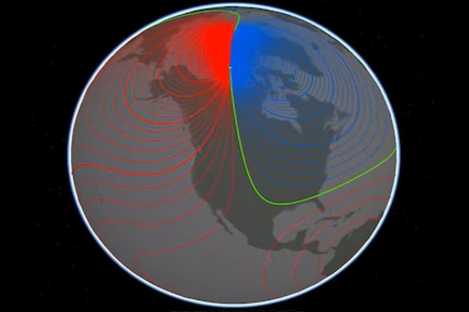Magnetic North Pole Moving Closer to Russia
The Earth’s magnetic North Pole is currently moving towards Russia, a shift reported by British scientists, who note that it was previously drifting closer to Canada. Historically, the magnetic North Pole had been drifting closer to Canada. However, in the 1990s, it shifted into the Atlantic Ocean. Recently, its speed towards Siberia has increased.
Magnetic vs Geographic North Pole
The magnetic North Pole differs from the geographic North Pole. The geographic North Pole remains stationary where all lines of longitude converge. Meanwhile, the magnetic North Pole’s location fluctuates due to changes in Earth’s magnetic field.
Historical Movement Patterns
Between 1600 and 1900, the magnetic North Pole moved approximately six miles annually. At the beginning of the 21st century, this rate increased to about 34 miles per year. In the last five years, the movement has slowed to around 22 miles per year.
Implications for Navigation
The movement of the North Pole impacts navigation tools. Compasses in smartphones and other devices rely on the magnetic North Pole’s position. Accurate navigation is essential for various modes of transport, including planes, boats, and submarines.
Monitoring and Prediction
The British Geological Survey and the U.S. National Oceanic and Atmospheric Administration collaborate to track the magnetic North Pole’s movements. They create the World Magnetic Model, which forecasts the pole’s location. This model is crucial for GPS systems used daily across the globe.
The movement of the magnetic North Pole stems from changes in Earth’s outer core. This outer core is primarily composed of molten iron, a liquid metal. Unpredictable flow patterns of this liquid lead to shifts in Earth’s magnetic field, causing the pole to relocate.
Important Facts for Exams:
- British Geological Survey – This organisation studies geological phenomena in Britain. It collaborates with NOAA to track magnetic pole movements. Its research is vital for accurate navigation and geoscience.
- World Magnetic Model – This model predicts the magnetic North Pole’s location. It is essential for GPS technology. It enables accurate navigation for various vehicles, including planes and submarines.
- Noaa – The National Oceanic and Atmospheric Administration monitors weather and ocean conditions. It plays a key role in environmental science. NOAA’s data supports climate research and disaster preparedness.
- Geomagnetic Field – This field results from Earth’s molten outer core. It influences navigation systems worldwide. Changes in the field can affect compasses and GPS accuracy over time.
Month: Current Affairs - November, 2024
Category: Science & Technology Current Affairs


